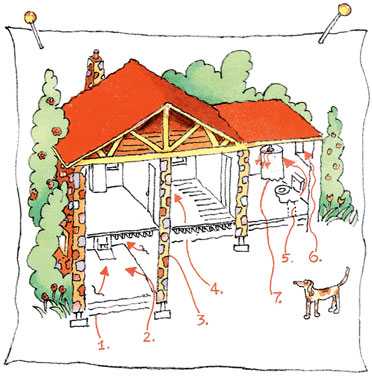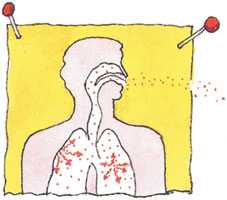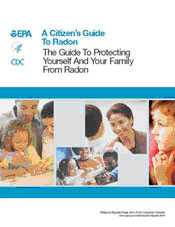Radon in the Home
What is Radon?
Radon is a gas that you cannot smell, taste or see. Radon forms naturally when uranium, thorium, or radium, (radioactive metals) breaks down in rocks, soil and groundwater. People can be exposed to radon primarily from breathing radon in air that comes through cracks and gaps in buildings and homes. Because radon comes naturally from the earth, people are always exposed to it.
- Having your home tested is the only effective way to determine whether you or your family is at risk of high radon exposure.
- For more information on testing your home, check with your state radon office or call the National Radon Hotline at 1-800-SOS-RADON.
National Radon Action Plan released on November 9, 2015
 The National Radon Action Plan: A Strategy for Saving Lives sets out strategies to drive the changes needed to reduce exposure to radon, a naturally occurring, invisible and odorless gas. This plan was released by the American Lung Association on November 9, 2015.
The National Radon Action Plan: A Strategy for Saving Lives sets out strategies to drive the changes needed to reduce exposure to radon, a naturally occurring, invisible and odorless gas. This plan was released by the American Lung Association on November 9, 2015.
Read the National Radon Action Plan on the American Lung Association’s website here
CDC’s Radon Communication Toolkit

For more information about radon, visit CDC’s new web page Protect Yourself and Your Family from Radon which brings together radon information from across the agency. CDC’s Radon Communication Toolkit, which is also featured on the new radon web page is designed for environmental and public health professionals to use to increase awareness and understanding of radon, its health effects, and the importance of testing for radon among the communities they serve. The toolkit contains customizable fact sheets, infographics, newsletter articles, and social media posts.
How Does Radon Enter Your Home?

The EPA lists the following ways that radon can get into buildings:
- Cracks in solid floors and walls (#1 and #3 in the figure)
- Construction joints (#2)
- Gaps in suspended floors (#4)
- Gaps around service pipes (#5)
- Cavities inside walls (#6)
- The water supply (#7)
For information on reducing radon levels in your home, please see the EPA page “Basic Radon Facts”.
Radon in Soil
Radon gets into the indoor air primarily through pores and cracks in the soil under homes and other buildings. Usually, the air pressure in homes and buildings is lower than the pressure outside in the soil around or underneath the foundation. The pressure difference will create suction. Radon will come through cracks due to that suction (even at low levels). For more information about the risks from radon in homes, please see EPA’s Assessment of Risks from Radon in Homes.
Radon in Water
Radon gas can be present in water that comes into your home. Radon is not a concern if the source of the water is from lakes, rivers, and reservoirs. In those cases, the radon is mostly released into the air before it enters your home. There may be a concern when your home’s water supply is from underground sources (groundwater), such as wells. For those instances radon can escape from the water during everyday activities such as drinking, washing dishes, cooking and showering. These actions could make a small contribution to the radon gas present in the air in your home.
For more information, please visit EPA’s website, Basic Information about Radon in Drinking Water.
Radon and Your Health
 When you breathe in radon, radioactive particles from radon gas can get trapped in your lungs. Over time, these radioactive particles increase the risk of lung cancer. It may take years before health problems appear.
When you breathe in radon, radioactive particles from radon gas can get trapped in your lungs. Over time, these radioactive particles increase the risk of lung cancer. It may take years before health problems appear.
Radon is the second leading cause of lung cancer after cigarette smoking. The U.S. Environmental Protection Agency and the Surgeon General’s office estimate radon is responsible for more than 20,000 lung cancer deaths each year in the U.S.
Smoking and Radon
 People who smoke and are exposed to radon are at a greater risk of developing lung cancer. EPA recommends taking action to reduce radon in homes that have a radon level at or above 4 picocuries per liter (pCi/L) of air (a “picocurie” is a common unit for measuring the amount of radioactivity).
People who smoke and are exposed to radon are at a greater risk of developing lung cancer. EPA recommends taking action to reduce radon in homes that have a radon level at or above 4 picocuries per liter (pCi/L) of air (a “picocurie” is a common unit for measuring the amount of radioactivity).
The chances of getting lung cancer are higher if your home has elevated radon levels and you smoke or burn fuels that increase indoor particles. For more information, please see Health Risks of Radon.
Your chances of getting lung cancer from radon depend mostly on:
- How much radon is in your home–the location where you spend most of your time (e.g., the main living and sleeping areas).
- The amount of time you spend in your home
- Whether you are a smoker or have ever smoked
- Whether you burn wood, coal, or other substances that add particles to the indoor air
For more information on cigarette smoking and radiation, click here
Protect Yourself and Your Family from Radon
Having your home tested is the only effective way to determine whether you and your family are exposed to high levels of radon. The U.S. Surgeon General recommends ALL homes be tested for radon gas.
Steps you can take to measure and reduce radon levels include:
- Purchasing a radon test kit
- Testing your home or office
- Testing is inexpensive and easy — it should only take a few minutes of your time. It requires opening a package and placing a small measuring device in a room and leaving it there for the desired period. Short-term testing can take from a few days to 90 days. Long-term testing takes more than 90 days. The longer the test, the more relevant the results are to your home and lifestyle.
- Sending the kit to appropriate sources to determine radon level
- Follow the directions on the test kit packaging to find out where to send the device to get the results.
- Fixing your home if radon levels are high
CDC worked with EPA to produce the booklet A Citizen’s Guide to Radon: The Guide to Protecting Yourself and Family from Radon. Over the years, federal, state, and local agencies have used this citizen’s guide to alert and to inform people about residential radon risks.
The publication includes information about the following:
- The Risks of Living with Radon
- Lowering Radon Levels in Your Home
- How to Test Your Home for Radon
- What your Test Results Mean
- Radon Myths
How a Radon Test Kit Works
When selecting a radon test kit, EPA recommends that you contact your state radon office for help in finding the radon kit that would work best for your home. You can measure radon levels in your home in two ways: short-term testing and long-term testing.
- Short-term radon test kits stay in your home for 2 to 90 days. A short-term test will give you quicker results, but it won’t tell you what your radon levels are throughout the year because radon levels change over the course of the day, with seasons, and with weather changes. Experts recommend testing your home at least two different times to get a better idea of how much radon is in your home.
- Long-term radon test kits stay in your home longer than 90 days. These will give you a better idea of what your radon levels are year-round.
Please contact the EPA hotline at 1 800 767-7236 for more information on short and long term test kits and how you can obtain a kit.
What Do Your Radon Test Results Mean?
EPA recommends taking action to reduce radon in homes that have a radon level at or above 4 picocuries per liter (pCi/L) of air.
Radon is measured in picocuries per liter of air (pCi/L). The lower the average pCi/L level in the air you breathe, the lower your risk of getting lung cancer. The chart below provides more information.
| If your radon level is | Take action |
|---|---|
| Higher than 4 pCi/L | Take a second test to make sure the first test results were accurate. You can use another short-term test, or you can buy a long-term test. Contact a licensed professional to install a radon reduction system if: • The average of both short-term tests is higher than 4 pCi/L • Results from a long-term test are also higher than 4 pCi/L |
| Between 2 pCi/L and 4 pCi/L | Consider installing a radon reduction system. If you do this, test for radon again in a few months to see how effective the system is for reducing radon levels. |
| Lower than 2 pCi/L | No action needed. Test your home again if you start living on a lower level (for example, if you turn your basement into a home office or extra bedroom). |
To find out more about radon test kits, contact the EPA Radon Hotlines and Information Resources or refer to the EPA radon web site on how to use a test kit.
Additional Ways to Take Action
The U.S. Department of Housing and Urban Development recommends additional actions you can take to reduce high radon levels in your home and protect yourself from an increased risk of lung cancer.
-
Stop smoking and discourage smoking in your home.
- Smoking significantly increases the risk of lung cancer from radon.
-
Increase air flow in your house by opening windows and using fans and vents to circulate air.
- Natural ventilation in any type of house is only a temporary strategy to reduce radon.
-
Seal cracks in floors and walls with plaster, caulk, or other materials designed for this purpose.
- Contact your state radon office for a list of qualified contractors in your area and for information on how to fix radon problems yourself. Always test again after finishing to make sure you’ve fixed your radon problem.
-
Ask about radon resistant construction techniques if you are buying a new home.
- It is almost always cheaper and easier to build these features into new homes than to add them later.
Related Links
CDC Related Links
- Cancer Prevention and Control– What States Can Do About Radon
- Environmental Health and Medicine Education
- Lung Cancer and the Environment
- Radon Monitoring and Data Collection in the United States
- Toxic Substances Portal for Radon, which provides several documents on radon and health
Environmental Protection Agency (EPA) Related Links
- The National Radon Action Plan (2015-2020)
- Federal Radon Action Plan (2010-2016)
- Final Federal Radon Action Plan Scorecard
- Map of Radon Zones
- How to Protect Your Family from Radon When Buying a Newly Built Home
- Radon Information for Kids, Students and Teachers
- Drinking Water Contaminants: Health Standards for Radon in Drinking Water
- Building A New Home: Have You Considered Radon?
Publications
- Radon Publications and Resources
- Consumers Guide to Radon Reduction: How to Fix your Home
- Toxicological Profile for Radon
- Radon – ToxFAQs
- Thorium – ToxFAQs
- Natural and Depleted Uranium – ToxFAQs
- Case Studies in Environmental Medicine – Radon Toxicity
Hotlines
- 1-800-SOS-RADON (767-7236)
- 1-800-426-4791 Safe Drinking Water Hotline
- Call CDC-INFO at 1-800-CDC-INFO or 1-888-232-6348
For more information, go to the EPA webpage
Radon in the Home
- Who Can Test or Fix Your Home?
- EPA’s Assessment of Risks from Radon in Homes
- U.S. Department of Housing and Urban Development-Office of Healthy Homes and Lead Hazard Control – Radon
Other related Links
- Page last reviewed: December 7, 2015
- Page last updated: May 31, 2017
- Content source:


 ShareCompartir
ShareCompartir
